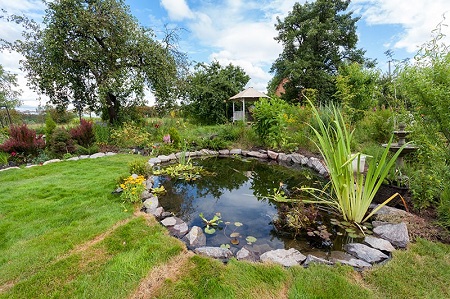Water features have been an integral part of garden design for centuries. Garden ponds, in particular, are an excellent way to add a serene and beautiful element to any outdoor space. Whether you have a small or large garden, a garden pond can be an attractive and relaxing addition to your landscape. In this article, we’ll cover everything you need to know about garden pond design and how to create a serene and beautiful water feature that will enhance your garden’s beauty.
A garden pond can transform your outdoor space into a tranquil and peaceful oasis. A well-designed pond can add a focal point to your garden, provide a natural habitat for wildlife, and help to create a calming atmosphere. In this article, we’ll explore the different types of garden ponds, how to choose the right location, the importance of pond filtration systems, pond lighting, and much more.
Benefits of Garden Ponds
Garden ponds offer several benefits, including:
- Aesthetic appeal: A well-designed pond can be a beautiful and eye-catching addition to your garden.
- Natural habitat for wildlife: Garden ponds provide a home for a variety of wildlife, including frogs, dragonflies, and fish.
- Promotes relaxation: The sound of running water can create a calming and relaxing atmosphere in your garden.
- Improves air quality: Water features like ponds can help to improve the air quality in your garden by releasing oxygen into the air.
- Increases property value: A well-designed pond can increase the value of your property.
Types of Garden Ponds
There are several types of garden ponds to choose from, including:
Natural Garden Ponds
Natural garden ponds are designed to look like a natural body of water. They typically have irregular shapes, and the edges are softened with plants and rocks. Natural garden ponds are often used in gardens with a more naturalistic or rustic design.
Formal Garden Ponds
Formal garden ponds are typically symmetrical and have a geometric shape, such as a square or rectangle. They often feature straight edges, and the water surface is calm and reflective. Formal garden ponds are often used in gardens with a more formal or traditional design.
Contemporary Garden Ponds
Contemporary garden ponds are characterized by their clean lines and simple design. They often feature a minimalist design, with a single water feature such as a fountain or waterfall. Contemporary garden ponds are often used in gardens with a more modern design.
Wildlife Garden Ponds
Wildlife garden ponds are designed to attract and support wildlife. They typically have shallow edges to allow animals easy access to the water. Wildlife garden ponds often feature a variety of plants, including those that provide food and shelter for wildlife.
Choosing the Right Location
When choosing the location for your garden pond, consider the following:
- Choose an area that receives at least six hours of sunlight a day.
- Avoid areas with overhanging trees or where leaves and debris can fall into the water.
- Choose a location with a level and stable base.
- Ensure that the pond is visible from your home or patio
Size and Depth
The size and depth of your garden pond will depend on a variety of factors, including the size of your garden, the type of plants and fish you want to include, and the amount of maintenance you are willing to do. A good rule of thumb is to make your pond at least 2 feet deep, with a surface area of at least 50 square feet.
Read more: Garden Lighting Design
Pond Liner Options
There are several options when it comes to pond liners, including PVC, EPDM rubber, and concrete. PVC liners are the least expensive but have a shorter lifespan. EPDM rubber is more expensive but has a longer lifespan and is more flexible. Concrete liners are the most expensive but are also the most durable.
Pond Filtration Systems
A filtration system is essential for keeping your pond water clean and clear. There are several types of filtration systems available, including biological filters, mechanical filters, and UV clarifiers. A combination of these filters is often the best option for maintaining a healthy pond ecosystem.
Pond Lighting
Pond lighting can enhance the beauty of your garden pond, as well as provide safety and security at night. LED lighting is the most popular option, as it is energy-efficient and can be easily controlled with a remote.
Choosing the Right Plants
The right plants can enhance the beauty of your garden pond while also providing essential oxygen for your fish. Water lilies, lotus, and water hyacinths are popular choices for garden ponds.
Adding Fish to Your Pond
Fish can add life and color to your garden pond, but it is important to choose the right type of fish for your pond. Koi and goldfish are popular choices, but they require a larger pond with a filtration system. Other options include mosquito fish, guppies, and minnows.
Maintenance Tips for Your Pond
Maintaining a healthy pond ecosystem requires regular maintenance, including cleaning the pond, removing debris, and checking the water quality. It is also important to monitor the pH and ammonia levels and to perform regular water changes.
Common Pond Problems and Solutions
Common pond problems include algae growth, low oxygen levels, and fish diseases. Solutions include adding more plants, increasing aeration, and treating the water with chemicals.
Conclusion
In conclusion, a well-designed garden pond can be a beautiful and calming addition to your outdoor space. By choosing the right location, size, and type of pond, as well as implementing proper maintenance and filtration systems, you can create a serene and beautiful water feature that enhances the beauty and value of your garden.
